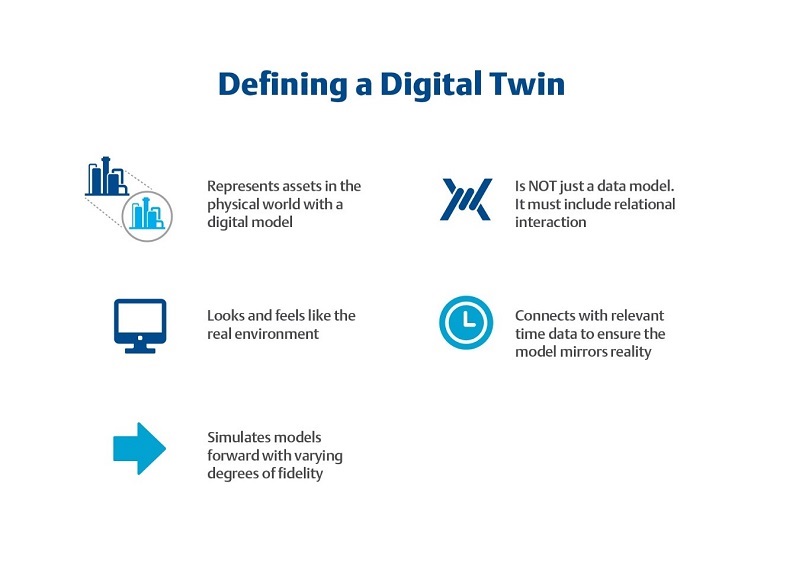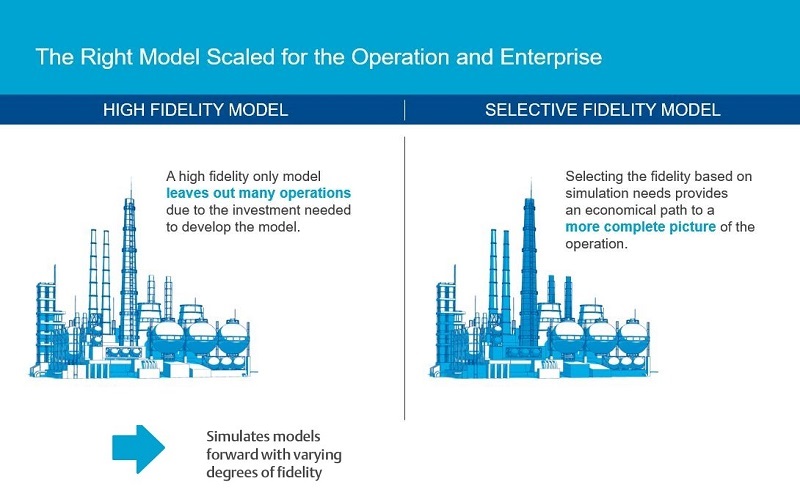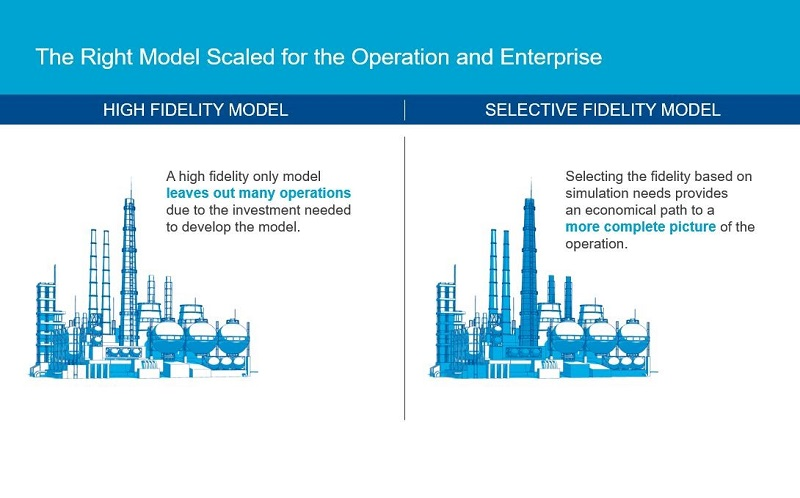Defining the digital twin: seven essential steps

|
| Using digital twins can support an effective digital transformation in the process industries by helping to save costs and time, and upskill staff. Car maker Tesla is known for having a digital twin for every car that it makes. |
[edit] Introduction
As manufacturers begin the process of digital transformation of their plants and assets, the need for technology to support this change to their plants’ operations is also growing.
A significant opportunity for digital transformation is found in the digital twin.
Teams hoping to drive the most value from digital-twin technology should look to seven essential criteria to ensure implementation of a system that will help drive improvement across the operation's lifecycle, and across the organisation.

|
| Versatile digital-twin technology supports a wide array of functionality across the plant life cycle. |
[edit] 1. A digital twin should be a practical investment
Digital twin architecture can be a practical investment to make, regardless of the size of the plant or industry where it will be used. To help drive better projects and operations, the digital-twin simulation functions as a flexible, scalable, holistic lifecycle tool.
Organisations and projects of any size can see value by using digital-twin simulation to reduce the cost and risk of improving operation and control of the plant, as well as supporting upskilling of the workforce.
[edit] 2. A digital twin should support distributed control system engineering
A holistic approach to the digital twin can improve process and control system engineering from the earliest stages of project design. The most advanced simulation technologies can leverage existing project assets by taking advantage of the project engineering team’s steady-state design models and integrating them — as dynamic process models — into a real-time dynamic simulation to speed and support process engineering execution.
A highly accurate digital twin built on engineering data also allows a project team to perform virtual commissioning to streamline projects. Virtualising the commissioning steps can simplify factory acceptance testing (FAT), making the process more efficient and taking it off the critical path, ultimately helping ensure projects stay on schedule.

|
| Steady-state, design models built with Aspen HYSYS can be converted into dynamic process models in HYSYS Dynamics, and then integrated with the real-time, dynamic simulation capabilities of Emerson's Mimic simulation software. |
[edit] 3. A digital twin should be designed with a best-cost basis, supporting the goals of projects and processes
To gain the most benefit as plants, processes, and assets change over time, digital-twin technology takes advantage of scalability to provide greater flexibility across a variety of assets and processes. To accommodate this scalability, selective approaches to model fidelity help organisations drive the most value over the longest time.
A rigid approach limited only to high-fidelity modelling will leave out some equipment and operations due to the investment required and the lack of accurate device models. In contrast, the selective fidelity approach to digital-twin simulation provides flexibility to change fidelity as necessary, allowing organisations to build a structure that can evolve and change with the plant’s needs.

|
| The Emerson Digital Twin uses a selective approach to model fidelity, low, medium and high, providing a more complete picture of the operation of the plant. |
[edit] 4. A digital twin should enable safe testing of process updates and changes
The same digital twin that allows for improving capital project execution also provides organisations with the tools they need to evaluate new control and operations strategies, as well as to develop and deploy advanced process control schemes.
Using a digital twin allows plant management to see the impacts that process control improvement will have on processes and performance — helping to continually keep the plant safe, efficient, and competitive without any risk to current operations.
[edit] 5. A digital twin should enable comprehensive training
It can take six to seven years to properly prepare a plant operator to make good decisions. A digital-twin solution can cut this time dramatically, offering a proven solution to improve the skills of operators — even before a plant begins operation.
On a digital-twin simulation, years of plant experiences can be compressed into months. As the engineering and construction phases of a project are being completed, operators can use that time to safely and accurately train in preparation for the operations phase.
Using a digital twin, operators can experience accurate representations of plant transitions and transient operations such as process events, startups, and abnormal situations. These are operations that are the most dangerous and least profitable to personnel and processes, but also rarely seen. This allows them to begin production more experienced, confident and qualified.
[edit] 6. A digital twin should be an accurate digital representation of physical-world assets
Digital-twin technology can help organisations safely and securely test and train new operating environments, but only if the users are provided with an accurate simulation.
The most advanced digital-twin simulations present an exact, complete replica of the control system configuration, ensuring that users interact with control system interfaces that are identical to those they will experience in the real world.
[edit] 7. A digital twin should be easy to use
In a properly implemented digital twin, the interactions between control data, historical data and design data should all be integrated in an elegant, easy-to-use structure that can evolve and change with the needs of the operation. These solutions combine real-time dynamic process and I/O simulation as well as operator-training options with industry-leading process modelling and high-fidelity dynamic simulation platforms.
When designed and integrated properly, these solutions can seamlessly integrate a variety of distributed control systems, programmable logic controllers, and emergency shut-down systems, while still delivering a seamless experience that mimics the plant floor.
Usability is key to successful digital transformations. The organisations that see the most benefit from digital transformation technologies are those that use them to improve plant operations, making it easier for personnel to quickly and confidently make the best decisions.
Digital twin technology is a foundation on which to support this digital transformation, an effective tool to support capital project execution as well as operational excellence initiatives for the lifecycle of the plant.
[edit] About this article
This article was written by Martin Berutti, VP of Process Simulation at Emerson. It was first published on the website of The Institution of Civil Engineers in April 2019 and can be accessed here.
[edit] Related articles on Designing Buildings Wiki
- Artificial intelligence and civil engineering.
- Big data.
- Blockchain technology in the construction industry.
- Career development for infrastructure leaders.
- Digital.
- Digital Roads 2025.
- Digital twin.
- Engineering Smart Cities.
- How can infrastructure be retrofitted in the digital age?
- Infrastructure that allows humans to flourish.
- Internet of things.
- Making the most of big data.
- National Digital Twin sounds exciting but we must do the hard stuff.
- Open data.
- Smart technology.
- Virtual reality and big data disrupting digital construction.
- What a digital twin could be.
Featured articles and news
Grenfell Tower fire – eight years on
A time to pause and reflect as Dubai tower block fire reported just before anniversary.
Airtightness Topic Guide BSRIA TG 27/2025
Explaining the basics of airtightness, what it is, why it's important, when it's required and how it's carried out.
Construction contract awards hit lowest point of 2025
Plummeting for second consecutive month, intensifying concerns for housing and infrastructure goals.
Understanding Mental Health in the Built Environment 2025
Examining the state of mental health in construction, shedding light on levels of stress, anxiety and depression.
The benefits of engaging with insulation manufacturers
When considering ground floor constructions.
Lighting Industry endorses Blueprint for Electrification
The Lighting Industry Association fully supports the ECA Blueprint as a timely, urgent call to action.
BSRIA Sentinel Clerk of Works Training Case Study
Strengthening expertise to enhance service delivery with integrated cutting-edge industry knowledge.
Impact report from the Supply Chain Sustainability School
Free sustainability skills, training and support delivered to thousands of UK companies to help cut carbon.
The Building Safety Forum at the Installershow 2025
With speakers confirmed for 24 June as part of Building Safety Week.
The UK’s largest air pollution campaign.
Future Homes Standard, now includes solar, but what else?
Will the new standard, due to in the Autumn, go far enough in terms of performance ?
BSRIA Briefing: Cleaner Air, Better tomorrow
A look back at issues relating to inside and outside air quality, discussed during the BSRIA briefing in 2023.
Restoring Abbotsford's hothouse
Bringing the writer Walter Scott's garden to life.
Reflections on the spending review with CIAT.
Retired firefighter cycles world to raise Grenfell funds
Leaving on 14 June 2025 Stephen will raise money for youth and schools through the Grenfell Foundation.
Key points for construction at a glance with industry reactions.
Functionality, visibility and sustainability
The simpler approach to specification.























